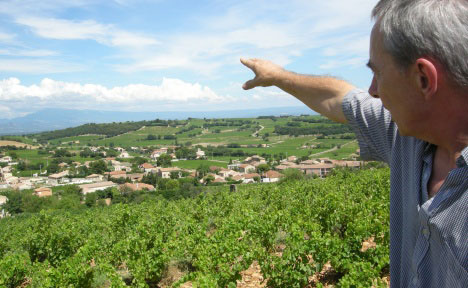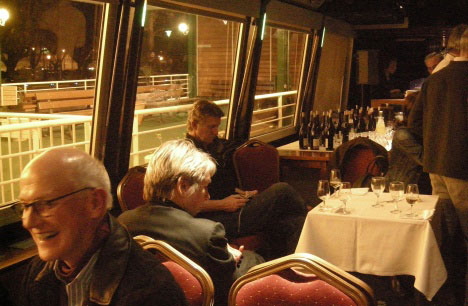At the "Découvertes en Vallée du Rhône" - an event that lasts six days and only takes place every two years - 750
winegrowers and wine houses present themselves. Wine regions and their wines are presented between Lion and Nîmes, from the
Côte Rôtie to the Costiéres de Nîmes. There are famous names, sought-after growths and well-known appellations such as
Hermitage,
Gigondas,
Vacqueyras, Châteauneuf-du-Pape.... But who knows
Luberon,
Rasteau or even
Cairanne? Names that come up from time to time. But they are names with which only obsessive lovers of
Rhône wines can really get to grips.
In the elongated Rhone Valley, too, one can make rewarding discoveries - as in almost all wine regions. A wine presentation like the "Découvertes" was actually created for this purpose. But the smaller places, the more modest names, the lesser-known estates usually get lost in the huge offer and are hardly noticed. This is also true of the two historic wine regions in the "Côtes du
Rhône Village"
appellation:
Rasteau and Cairanne. One of the
villages,
Rasteau, in the north of the department of
Vaucluse, may be known for its sweet wines - "Vin
doux naturel" - but who knows the other 15 communes that are allowed to bear their place names on the
AOC labels,
Séguret,
Sablet,
Laudun, Cairenne and all the others, as a guarantee of quality? Friend Max-Georg discovered a small inconspicuous note in the extensive programme of the "Découvertes" and reacted immediately, signing us up for a "Croisière nocturne sur le Rhône", a night cruise on the Rhone around Avignon. It was organised by the
winegrowers in
Cairanne and Rasteau.
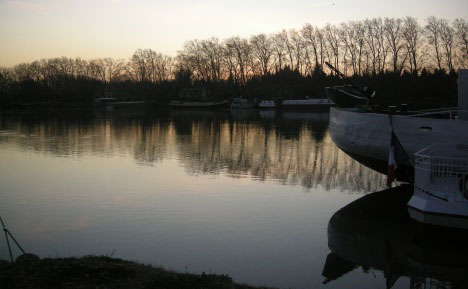 |
| An atmospheric night on the banks of the Rhône |
I could have easily overlooked the invitation. Even in Wine lexicon I had to look it up
first to know where these winemakers with their friendly invitation were at home. I learn that wine has always been the focus there, for 4000 years. But
viticulture actually only began here in 300 BC, when the "Voconces" tribes occupied the land and cultivated vines.
Viticulture, an ancient tradition in this region. But what are the wines like today that come from
Cairanne or
Rasteau? How do they work, how do they live, what do the
winegrowers think, who today are rather off the beaten track of the global wine business? The invitation to the night cruise was meant to give us - and about 200 other fellow travellers - an insight. We expected advertising, information, a flood of praise and (as is usually the case at such events) big words. None of this materialised. Very modestly, there are two brochures on a table: "Rasteau - le
Vignoble aux 3 Appellations" and "Les marchés en Provence". That's all! On a large poster, the
winegrowers of
Rasteau and
Cairanne thank us in simple words for the interest in their products and wish us all an enjoyable evening. All the wines of the two communes are available. For the uninitiated, they are hard to classify, you just have to pour them and taste them.
In addition, food is served, small appetisers, larger delicacies, specialities of the region, products of a region. Again and again, until even the hungriest have eaten enough. And all this is done unobtrusively, without advertising, so completely focused on three hours of pleasure. No price lists, no long speeches, no information sheets with facts and figures, no wine descriptions with the terms we are familiar with: "cherry-red colour, flowery fragrance, slender tannins, fat and oiliness of taste, red fruits and blackcurrants......". No, each participant can simply taste, red, white, dry or sweet wines. I quickly took a glass to the upper deck to see Avignon, the city of the popes, in a different light. From the river, embedded in the darkness of the night, lightly touched by the dull glow of the moon. At
first I am almost alone, later in the company of many a cheerful guest. They all have a glass in their hand and discuss in many languages: English, German, Danish, Czech, French..... The discussion is less about the wine - hardly two people have the same wine in their glass - and more about the atmosphere, the situation of the
winegrowers, the landscape, the river, the historic city, the many witnesses of history - and of course about the love of wine.
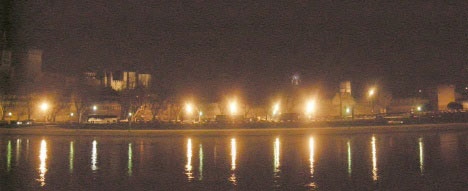 |
| Avignon% the city of the popes% at night by moonlight |
No, almost nothing is the same as in other presentations. Of course you can feel the pride of the
winegrowers here too, you meet the representatives of the wine syndicates who promote their cause. Of course, the
winegrowers present their wines in conversation when asked. Here, too, everyone connected with these wines meets: Traders, innkeepers, friends, consumers,.... But it's all about a few hours of enjoyment. No sooner has the ship returned than it moors again at the gates of Avignon, the rather haphazard ship's community disperses, loses itself to the winds, to all regions, even to different countries. And - do they know
Rasteau or
Cairanne now? No, they certainly don't. The information was too scarce, too arbitrary, too little systematic for that. Not even the two
villages were
seen, because they are a good 30 kilometres away from Avignon. Perhaps one or the other "particularly good wine" was drunk, perhaps one encountered wines that were not tasty or not tasty at all. Each participant probably experienced the evening differently.
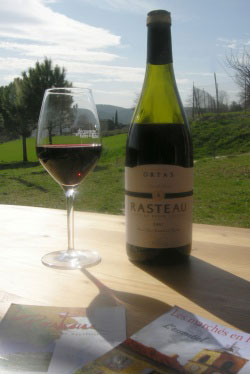 |
| Experience in Provence. A Rasteau (Tradition) in the glass as I write this column. |
Was the invitation worth it, for the winemakers, for the participants? In any case, I henceforth associate
Cairanne and
Rasteau with a moonlight drive, lined left and right by the banks of the Rhone. For me, the wines have not become what I will henceforth "run after", but products of a landscape, a region, a culture, in short, of people I have met. And now, as I write this column, I feel the need to open one of the bottles I took with me and drink it in the tranquillity of the Provençal countryside. And I know I will come again; I will no longer simply leave the two
villages to the left, but will visit them at some point, I will drink their wines again, talk about them and experience them with different feelings than the thousand other wines I was introduced to on the Rhone.
Sincerely
Yours
Peter (Züllig)
